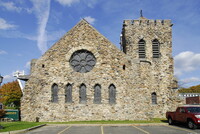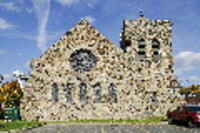| dc.coverage.spatial | Site: Williamstown, Massachusetts, United States | en_US |
| dc.coverage.temporal | 1895-1896 (creation); 1955 (alteration) | en_US |
| dc.creator | Rotch & Tilden | en_US |
| dc.date | 1895-1896 | en_US |
| dc.date.accessioned | 2013-09-04T15:39:41Z | |
| dc.date.available | 2013-09-04T15:39:41Z | |
| dc.date.issued | 1895-1896 | en_US |
| dc.identifier | 232818 | en_US |
| dc.identifier.other | archrefid: 2669 | en_US |
| dc.identifier.uri | http://hdl.handle.net/1721.3/140264 | |
| dc.description | View of gable end wall of nave with stained glass windows, upper rose window; The church parish was organized in 1894. Harley T. Proctor donated glacial fieldstone from Stone Hill (above the present Clark Art Institute) which gives the building its heavily rusticated look and reproduces the historic Romanesque and Gothic church type known as Feldsteinkirche, which was used again in Romanesque Revival styles. This church copies Norman Romanesque examples. The firm partners were Arthur Rotch (1850-1894) and George Thomas Tilden (1845-1919). Some of the stained glass (ca. 1895-1950) comes from the Boston studios of Charles Connick. The present church school and office building was added in 1955. Source: Saint John's Episcopal Church, Williamstown [website]; http://saintjohnswilliamstown.org/ (accessed 6/20/2012) | en_US |
| dc.format.medium | glacial fieldstone | en_US |
| dc.rights | © Scott Gilchrist, Archivision, Inc. | en_US |
| dc.subject | architecture | en_US |
| dc.subject | revival styles | en_US |
| dc.subject | Romanesque Revival | en_US |
| dc.subject | Nineteenth century | en_US |
| dc.title | Saint John's Episcopal Church, Williamstown | en_US |
| dc.type | image | en_US |
| dc.rights.access | Licensed for educational and research use by the MIT community only | en_US |
| dc.identifier.vendorcode | 1A1-BAW-SJEC-A2 | en_US |
| vra.culturalContext | American | en_US |
| vra.technique | construction (assembling) | en_US |
| vra.worktype | church | en_US |
| dc.contributor.display | Rotch & Tilden (American architectural firm, 1880-1895) | en_US |



